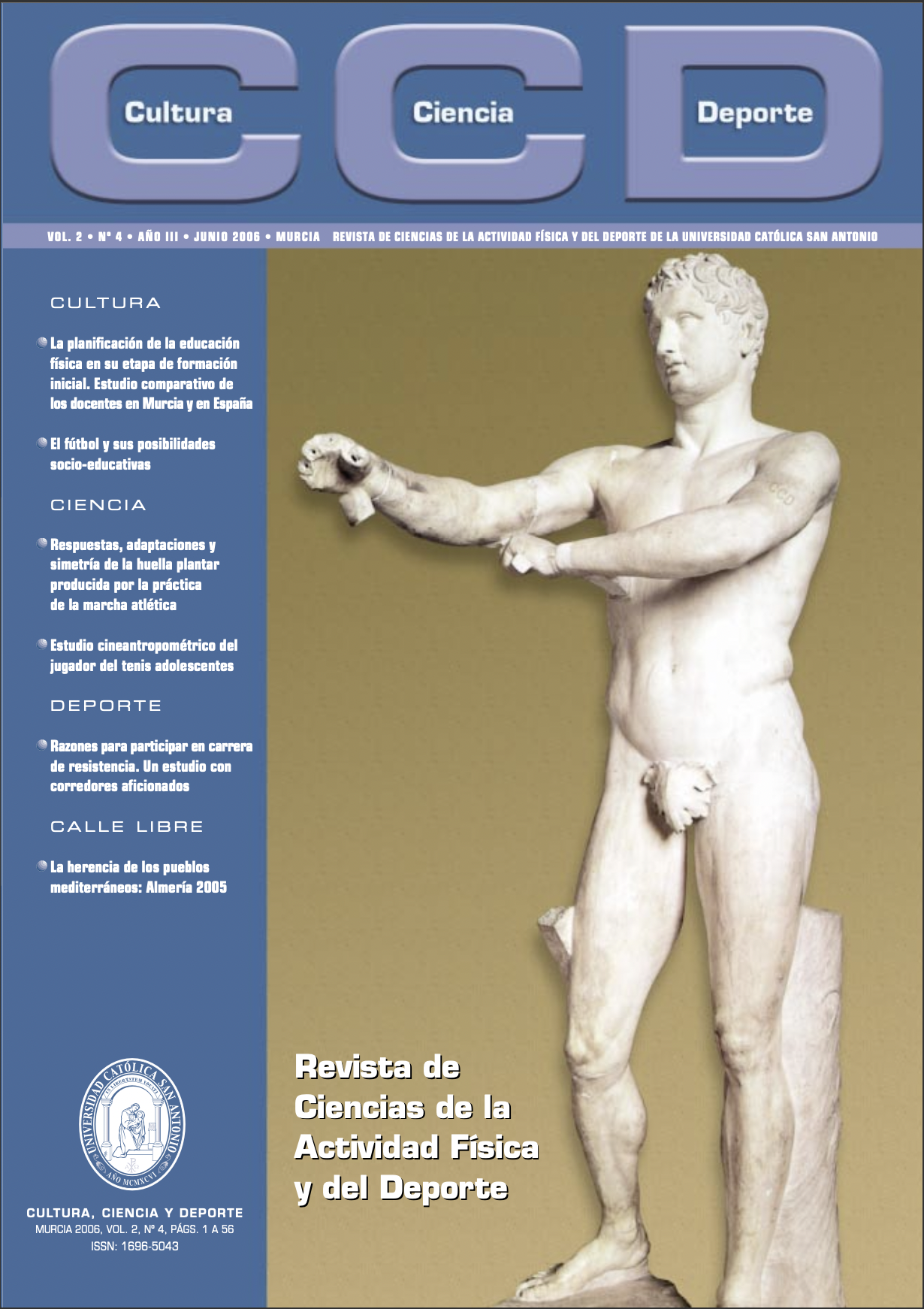Respuestas, adaptaciones y simetría de la huella plantar producidas por la práctica de la marcha atlética. (Answers, adaptations and symmetry of the track to plant produced for the practice of the athletic march).
DOI:
https://doi.org/10.12800/ccd.v2i4.169Resumen
El propósito de este trabajo fue determinar el efecto que tiene la práctica de la marcha atlética sobre las estructuras del pie, tanto en las respuestas inmediatas a la práctica como en las adaptaciones a largo plazo por el entrenamiento. Para ello se realizaron tres tomas de la huella plantar por el método el fotopodograma a una muestra de 17 marchadores jóvenes. La primera y segunda toma se realizaron en ambos pies a mediados de temporada, en reposo y tras 30 min de marcha respectivamente. La tercera toma también en reposo sobre el pie dominante 3 meses después, al final de la temporada. Los resultados indican que no hay diferencias entre el pie derecho e izquierdo, ni antes ni después del ejercicio. Sin embargo, al analizar el efecto en las respuestas se encontraron comportamientos distintos. Mientras que el pie derecho mostró incrementos significativos en el ancho del antepié y mediopié (P < 0,05), en el pie izquierdo se manifestó un incremento en la longitud del pie. Este comportamiento distinto puede deberse a las características del circuito sobre el que se realizó la marcha, circular con giro a la izquierda. Esto nos lleva a sugerir que para evitar posibles sobrecargas y descompensaciones los entrenamientos se desarrollen en circuitos equilibrados en curvas a ambos lados, o en caso de realizarse en circuito cerrado, que se cambie con frecuencia el sentido de giro. En cuanto a las adaptaciones, siguen un patrón similar al de las respuestas del pie derecho, se encontraron incrementos significativos en el ancho del antepié, aunque también se incrementó significativamente la longitud del pie, si bien creemos que esto último puede haberse debido al desarrollo propio de los atletas, ya que muchos se encontraban en edad de crecimiento.
Palabras clave: biomecánica, huella plantar, respuestas, adaptaciones, marcha atlética.
===
Abstract
The purpose of this paper was to determine the effect of the race walking exercise on the structures of the foot, so much in the immediate responses to the practice as in the long term training adaptations. Footprints were recorded tree times using the photopodogram methodology on a sample of 17 young race walkers. The first one and second footprints were carried out in both feet at the middle of the season, in rest and after 30 min race walking respectively. The third was taken in rest on the dominant foot 3 months later, at the end of the season. The results indicate that there are not differences among the right and left foot, neither before nor after the exercise. However, the responses showed different behaviour. While the right foot showed significant increments in the width of the forefoot and midfoot (P < 0.05), the left foot showed an increment in the length of the foot. This different behaviour can be due to the characteristics of the circuit on which the race walk was carried out, circular with turn to the left. This takes us to suggest that, to avoid overloads and muscular unbalances the race walkers should train in circuits balanced in curves to either sides, or if in circular circuits frequently change the turning sense. The adaptations followed a similar pattern to that of the responses of the right foot. There were significant increments in the width of the forefoot, although the length of the foot also increased significantly. Anyway, we believe that the last could be due to the intrinsic characteristic of the athletes, since many of them were in age of growing.
Key words: biomechanics, footprint, responses, adaptations, race walk.
Descargas
Cómo citar
Número
Sección
Licencia
Los autores que publican en esta revista están de acuerdo con los siguientes términos:- Los autores conservan los derechos de autor y garantizan a la revista el derecho de ser la primera publicación del trabajo al igual que licenciado bajo una Creative Commons Attribution License que permite a otros compartir el trabajo con un reconocimiento de la autoría del trabajo y la publicación inicial en esta revista.













